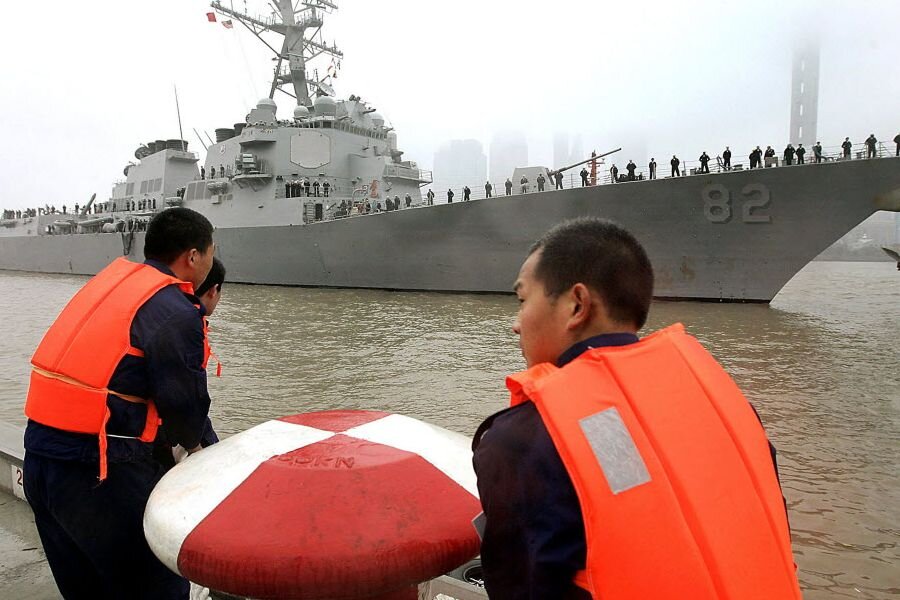US warship in South China Sea: What's at stake?
The passage of a United States Navy destroyer near one of China’s artificial islands in the South China Sea may mark the reemergence of traditional geopolitical tensions in a region long preoccupied with domestic economic concerns.
In other words, this is about much more than a warship far from home sailing within a few miles of a bunch of rocks.
In sending the USS Lassen into waters near the Spratly Islands, the US is pushing back – hard – against China’s assertion that the much-trafficked maritime area represents part of its territory. Washington and its regional allies say that piling up material on reefs whose ownership is contested does not constitute any kind of nation-building under international law.
But China is unlikely to stop its massive reclamation project because of an American “freedom of navigation” exercise. In recent years, it has accelerated its efforts to create an artificial ring of sand to bolster its disputed South China Sea claims. Under President Xi Jinping, an increasingly nationalist Beijing appears to be trying to break out of what it sees as its entrapment by an arc of US allies, from Japan through Korea and the Philippines.
One worry here is that a small mishap could blow up into a larger physical confrontation. But the larger issue is that the status quo is not returning. How will the US, China, the Philippines, Vietnam, Malaysia, and other interested parties establish rules for interaction in sea lanes that carry upwards of 30 percent of world trade?
“The real question is can the diplomacy of the Asia-Pacific region handle these new pressures?” said Council on Foreign Relations president Richard Haas in a recent CFR guide to China’s maritime disputes.
Why this incident was different
In this context, the sail-past was not a surprise. If anything, it’s surprising that the Navy did not carry out this mission sooner.
After all, the US often uses its warships in freedom-of-navigation exercises, all over the globe. These are a means of disputing what Washington considers excessive claims of sovereignty. In 2014, for instance, the US carried out freedom-of-navigation cruises against some 19 nations, including China, according to the most recent public Navy report on the subject.
The difference this week was that the US intention to carry out some sort of patrol in the South China Sea was the subject of numerous news leaks and much regional speculation. It was public, and meant to be so, in a way that such moves usually aren’t.
“Make no mistake, the United States will fly, sail and operate wherever international law allows, as we do around the world, and the South China Sea is not and will not be an exception,” said Secretary of Defense Ash Carter earlier this month.
China has long claimed ownership of the entire South China Sea, and all the various nubbins of land within it. But other nations which border these waters have long made countervailing claims.
Bejing has not formally tried to assert sovereignty over a 12-mile territorial sea surrounding its new artificial islands. It has built buildings and runways capable of handling some military aircraft, however.
Under international law, warships have rights of innocent passage through territorial waters without notification. However, China labeled “illegal” the Lassen’s late Monday transit near Subi Reef in the Spratly Islands.
“The actions of the US warship have threatened China’s sovereignty and security interests, jeopardized the safety of personnel and facilities on the reefs, and damaged regional peace and stability,” said China’s Foreign Ministry on its website.
What happens next
Undoubtedly China will continue with its slow expansion of a physical presence in the Spratly Island area. President Xi’s popularity is based in part on his expression of an assertive nationalist vision. At this point, it would be difficult for him to obviously back down.
But the US move may reassure nervous allies. And there are a number of further steps Washington might take that could help deter Bejing from further blatant aggression, according to a recent Center for Strategic and International Studies policy paper on the South China Sea challenge.
For instance, the US could push regional allies, such as Japan and Australia, to carry out their own freedom-of-navigation exercises. It could release its own public accounting of the status and history of the South China Sea features that are being developed into “islands." It could think about committing the US to the defense of Philippine troops now stationed on islands claimed also by China.
Given the web of historical claims and counterclaims that enmeshes the seven or so different players in the South China Sea, there are no easy solutions, writes the Center for Strategic and International Studies' Southeast Asia expert Gregory B. Poling.
“Any successful policy must distinguish immediate needs – deterring Chinese aggression, reassuring claimants of US commitment, and preventing tensions from increasing further – from long term interests – preserving the global maritime commons, convincing all parties to bring claims into conformity with international law, and establishing a long-term system to manage disputed waters and seabed,” writes Mr. Poling.







